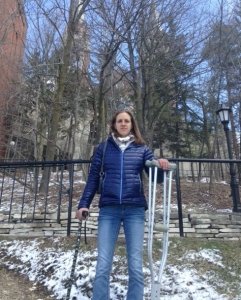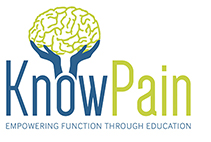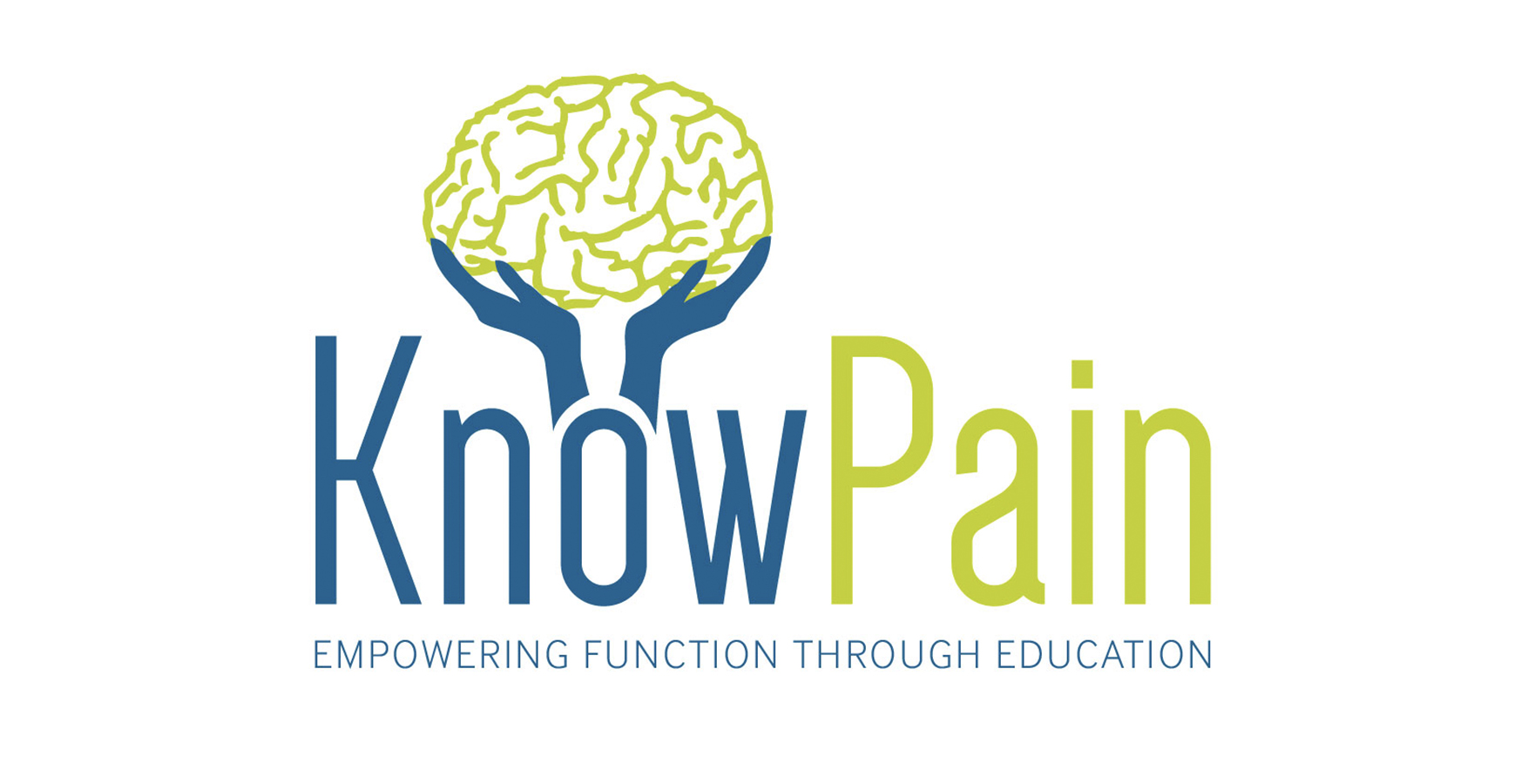Breaking the Silence About a Silent Disease: One Voice of Chronic Pain
by Leda McDaniel

“Hey, I can hear you coming from a mile away!”
I sat down gingerly and tried to avoid eye contact with the speaker of that statement and fake a wan smile, but in all honesty I was fighting back tears. The comment came from a classmate of mine in my first year physical therapy class and it was in reference to my use of crutches (and the noise they made) coming down the hallway on my way to class. I had been on crutches for about 4 months at that point and would use them for a full year due to the chronic pain that I had developed in my left knee after complications from two surgeries (I had been diagnosed with complex regional pain syndrome). Hearing a comment like that was not uncommon for me and during the three-year period that I spent coping with chronic knee pain, I experienced many different reactions to my chronic pain and disability.
In some interactions with others, I found solace and was met with loving presence and compassion. Unfortunately, many of the conversations that I had with healthcare professionals, family and friends, and passing acquaintances were filled with openly hostile, hurtful, and critical remarks about my condition.
I am currently a Doctorate of Physical Therapy student at Ohio University and I have experienced both the patient and the health care provider perspectives of chronic pain. I wish to speak out about the stigma and negative stereotypes that I experienced as a chronic pain sufferer with the aim of sparking dialogue and hopefully provoking positive changes in how we treat those with this disease. Here are some examples of how people reacted to me when I was in chronic pain…
Health Care Professionals
How I Was Treated By Healthcare Professionals:
- As if I was faking my pain or making it up
(The fancy word in the medical field for this is “malingering”):
Multiple doctors: “Since you are so long out of having surgery, you should be just fine. I suggest that you just start to walk you should be able to run too.”
“If you are still having pain: well there’s really no good explanation for it”
“We can’t find a cause for your pain, you should go see a psychologist”
(The best scientific evidence does NOT support psychological risk factors or psychological causes for Complex Regional Pain Syndrome (what I was diagnosed with)1,2
- As if I was an annoyance/wasting their time:
From one doctor: “There is nothing wrong with your MRI, the surgery went well, and there is not really anything else we can do for you”
Multiple physical therapists: “you just have to get your quad stronger, are you doing your exercises? Pain is part of having surgery”
(At this point I was well past “quad inhibition” and post-surgical pain, we’re talking 8-12 months after knee surgery).
I have heard from multiple doctors and physical therapists the “joke” of groaning or being unhappy when they see a chronic pain patient on their schedule. When will we acknowledge that this language and attitude is harmful as it perpetuates negative stigma for these patients?
https://www.jospt.org/doi/full/10.2519/jospt.2018.0610
- Like a drug seeker
From one doctor: “We can’t give you this pain medication even though it is helping because it may be addictive.”
(I had stated that I had no desire to take medication- but this was the only thing that dulled my pain at one point. I had no history of substance abuse and did not possess the risk factors for opiate addiction)
How I Wanted To Be Treated By Healthcare Professionals:
- With objectivity and an unbiased assessment of the signs and symptoms of my condition
- With evidence-based treatment options
- With compassion and empathy for the human suffering I was going through
- With appropriate communication/recommendation to other healthcare professionals as needed
Friends and Family
How I Was Treated By Friends and Family:
- With Unconditional Love, Encouragement/Support, Empathy
I was blessed to have a few individuals in my life who went to great lengths to demonstrate their love and concern and were constant sources of support and encouragement. These individuals made the effort to spend time with me despite my limitations and to talk with me about my experience despite any discomfort or unpleasantness it may have caused them. I am incredibly grateful for the thoughtful treatment from these few family members and friends.
- With Disbelief and/or Denial
“Why can’t you just walk?”
“Why don’t you just do ______ (yoga, Pilates, swimming, stretching)?
(The reality was I could not even move or touch my knee without being in severe nerve pain. There was a huge disconnect between what I was experiencing and others’ misunderstanding or inability to differentiate chronic pain from acute pain they had experienced)
“How can you still be in that much pain?”
“I had pain after my knee surgery too, you know”
How I Wanted To Be Treated by Friends and Family:
- With unconditional love
- With encouragement and support
- With empathy (an attempt to understand my suffering)
Strangers/Acquaintances:
How I Was Treated by Strangers and Acquaintances
- With Ridicule/Derision (veiled “joking”)
“I can hear you coming from a mile away” “Hey want to race?” “When are you going to get off of those things?”
(Reactions to seeing me on crutches and the long time I spent on crutches: 1 year total)
“Why aren’t you better by now?”
“At least you get a good parking space” (reaction to my handicap parking sticker)
- With Comparison Statements
“Oh yeah, I was on crutches for a week after I sprained my ankle, it was the worst!”
“I was back to playing basketball within a year after ACL surgery, you just have to get your leg strength back”
How I Wanted To Be Treated by Strangers and Acquaintances:
- With human decency and kindness, with understanding
Concluding Thoughts:
Treating chronic pain is no easy feat and I want to acknowledge that. However, the negative interactions that I experienced, I believe, were part of a larger marginalization of those with chronic pain that I wish to bring light.
My intent in sharing these interactions is not to criticize one particular person or group of people. Merely, I would like to encourage reflection on the part of individuals who interact with people in chronic pain. I think that we can do better as healthcare providers, friends, family members, and even as a society in bringing thoughtfulness to our language and actions as we work to support these individuals in their pursuit of health and wellbeing.
Leda is a current Doctorate of Physical Therapy (DPT) candidate at Ohio University and upon graduating in May 2019 is interested in working with patients with various chronic pain conditions.
Leda recently published a book about her experience of personal recovery from chronic pain, which you can find on Amazon:
https://www.amazon.com/dp/069212120X?ref_=pe_870760_150889320
You can also find her blogging at:
https://sapiensmoves.wordpress.com/
References:
- Harden RN, Oaklander AL, Burton AW, et al. Complex regional pain syndrome: practical diagnostic and treatment guidelines, 4th edition. Pain Med 2013;14:180–229.
- Marinus J, Moseley GL, Birklein F, et al. Clinical features and pathophysiology of complex regional pain syndrome. The Lancet Neurology. 2011;10(7):637–648.

